Limited male incubation ability and the evolution of egg size in shorebirds
| dc.contributor.author | Lislevand, Terje | eng |
| dc.contributor.author | Thomas, Gavin H. | eng |
| dc.date.accessioned | 2006-06-26T08:13:16Z | |
| dc.date.available | 2006-06-26T08:13:16Z | |
| dc.date.issued | 2006-06-22 | eng |
| dc.Published | Biology Letters 2(2) | |
| dc.identifier.issn | 1744-9561 | en_US |
| dc.identifier.issn | 1744-957x | en_US |
| dc.identifier.uri | http://hdl.handle.net/1956/1462 | |
| dc.description.abstract | In bird species where males incubate but are smaller than females, egg size may be constrained by male body size, and hence ability to incubate the eggs. Using data from 71 such shorebird species, we show that egg size decreases as the degree of female-biased sexual size dimorphism increases, after controlling for female body mass. Relative egg size was not related to mean clutch size. However, when controlling for mating system, the relationship between female-biased sexual size dimorphism and relative egg size was only significant in polyandrous species. The relatively small eggs of socially polyandrous shorebirds have previously been explained as an energy-saving strategy associated with the production of multiple clutches. Our findings suggest that egg size evolution is better explained by male incubation limitation in these birds. | en_US |
| dc.format.extent | 95855 bytes | eng |
| dc.format.mimetype | application/pdf | eng |
| dc.language.iso | eng | eng |
| dc.publisher | The Royal Society | en_US |
| dc.subject | Incubation | eng |
| dc.subject | Egg size | eng |
| dc.subject | Shorebirds | eng |
| dc.subject | Waders | eng |
| dc.subject | Brood patch | eng |
| dc.title | Limited male incubation ability and the evolution of egg size in shorebirds | en_US |
| dc.type | Peer reviewed | |
| dc.type | Journal article | |
| dc.identifier.doi | https://doi.org/10.1098/rsbl.2005.0428 | |
| dc.subject.nsi | VDP::Matematikk og Naturvitenskap: 400::Zoologiske og botaniske fag: 480 | nob |
